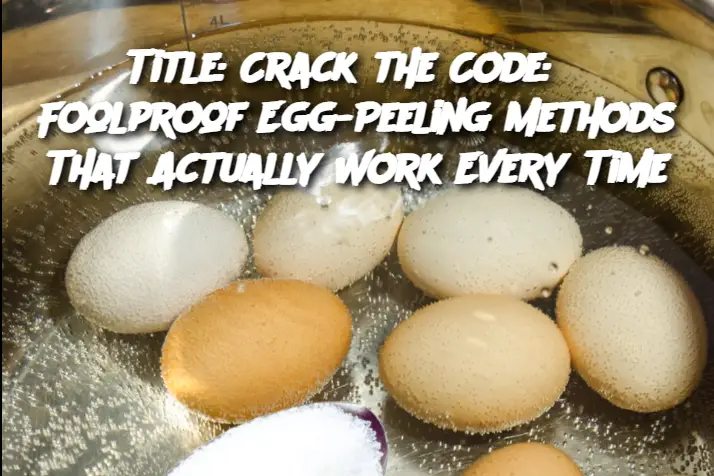-
Fresh or slightly older eggs (preferably 7–10 days old for easiest peeling)
-
Water
-
Ice (for ice bath)
-
Optional: Baking soda or vinegar for certain methods
Preparation (Boiling the Eggs):
No matter the peeling method, start with well-cooked eggs:
-
Place eggs in a pot and cover with cold water by 1 inch.
-
Bring to a gentle boil over medium heat.
-
Once boiling, reduce to a simmer and cook for 9–12 minutes, depending on desired doneness.
-
Immediately transfer eggs to an ice water bath for at least 10 minutes.
5 Foolproof Peeling Methods:
1. The Ice Bath Shock Method
After boiling, place eggs in an ice water bath for 10–15 minutes. This cools the eggs quickly, causing the egg whites to contract and pull slightly away from the shell.
✅ Best for: Everyday boiled eggs
💡 Tip: Crack the shell gently under running water for extra ease.
2. Shake in a Jar (or Tupperware)
Place a boiled egg in a small jar or plastic container with a little water. Shake gently for a few seconds until the shell is cracked all over. The shell will slide off with ease.
✅ Best for: Peeling multiple eggs quickly
💡 Tip: Use a wide-mouthed container for best results.
3. Crack and Roll Method
Crack the egg on a hard surface, then gently roll it with the palm of your hand to loosen the shell all over. Start peeling from the wider end, where the air pocket is.
✅ Best for: Gentle, hands-only peeling
💡 Tip: Use under cool running water to help the shell lift off.
4. Add Baking Soda or Vinegar to the Water
Adding 1 teaspoon of baking soda or 1 tablespoon of vinegar to your boiling water helps weaken the eggshell’s bond to the white, making it easier to peel.
✅ Best for: Fresh eggs that are usually harder to peel
💡 Tip: Especially helpful when you’re boiling eggs from the farm or fridge.
5. Steam Instead of Boil
Place eggs in a steamer basket over boiling water, cover, and steam for 13–14 minutes. Cool in ice water and peel. The steam penetrates the shell and loosens it beautifully.
✅ Best for: Ultra-easy peeling with less cracking
💡 Tip: This method also makes the shells easier to crack evenly.
Serving and Storage Tips:
-
Serve immediately with salt, pepper, or your favorite seasoning.
-
Use peeled eggs in salads, sandwiches, deviled eggs, ramen, or enjoy on their own.
-
Store peeled eggs in an airtight container with a damp paper towel for up to 5 days in the fridge.
-
Keep unpeeled boiled eggs refrigerated for up to 1 week.
Variants (Add Flavor or Flair):
-
Tea Eggs: Soak peeled eggs in a spiced soy tea bath for flavor.
-
Pickled Eggs: Preserve in vinegar brine with herbs and spices.
-
Spicy Deviled Eggs: Use peeled eggs to make sriracha or jalapeño deviled versions.
-
Rainbow Eggs (Kids’ Favorite): Soak peeled eggs in colored water for a festive touch.
FAQ:
Q: Why are some eggs harder to peel than others?
A: Very fresh eggs have a tighter bond between the shell and membrane. Slightly older eggs (7–10 days) are ideal for easier peeling.
Q: Is peeling under running water better?
A: Yes! The water helps get under the membrane and makes peeling smoother.
Q: Can I reuse the ice bath?
A: Absolutely—just add more ice if it starts to warm. Cold water is key to stopping the cooking process.
Q: Do brown eggs peel differently than white eggs?
A: No—peeling ease depends more on freshness than shell color.
Q: Can I peel eggs ahead of time for meal prep?
A: Yes! Store peeled eggs in the fridge in a sealed container for up to 5 days.
Conclusion:
No more struggling with stubborn shells or ruined eggs! With these 5 foolproof peeling methods, you’ll master the art of the perfect peel every time—whether you’re making a dozen for a party or just one for your toast. It’s time to say goodbye to frustration and hello to beautifully smooth, ready-to-eat boiled eggs. 🥚✅
